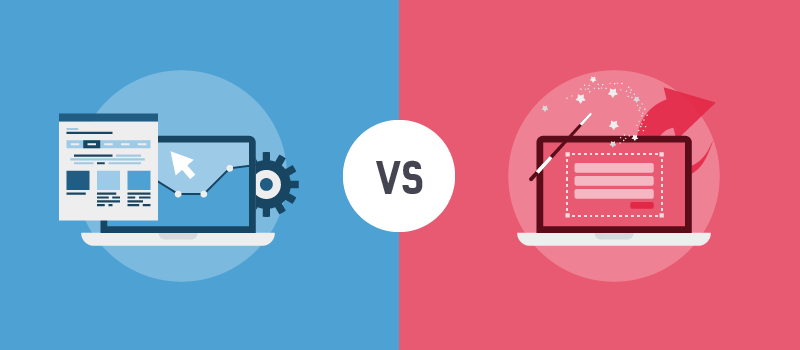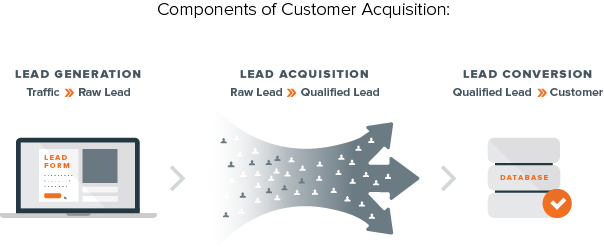Lead Generation vs. Lead Acquisition: What is the difference?

The phrases “Lead Generation” and “Lead Acquisition” are two closely related terms with different meanings that are often conflated. While they both fall under the “Customer Acquisition” category, each refers to different parts of the customer acquisition process. Because it is common for these terms to be used interchangeably, and I’ve never read an article differentiating the two, I’ll explain the differences here.
Since the term “Lead” is used in many ways, I’ll limit the scope of this article to digital marketing, and define a lead as a consumer who has filled out a web form requesting to be contacted about goods or services. A lead can be a consumer requesting contact by a salesperson, an email newsletter subscriber, or someone downloading marketing content in exchange for their contact information. These are also known as internet leads or web leads. In this modern context, where platforms like TikTok play a significant role in digital marketing strategies, understanding how to effectively get TikTok followers can also be seen as a form of lead generation, encouraging users to engage more deeply with your brand. This adds a new dimension to the lead generation process, reflecting the evolving nature of customer interaction in the digital age.
Lead generation, then, refers to the process of encouraging individuals to submit their contact info in the form of a lead, and lead acquisition refers to the process of acquiring leads from your various lead generation sources, including social media channels.

Diving deeper, lead generation is about buying media and converting web traffic into a lead. If you buy search traffic on Google with the goal of convincing those site visitors to submit a form on your site, you are generating leads. And if you’re buying leads for your specific industry or career, for example, buying real estate leads for agents, you’re getting targeted leads that are more likely to earn you a sale. Lead generation covers the entire process of buying media, targeting users, and optimizing the landing page. This is a distinct business practice that involves specialized roles like display media buyers, affiliate marketing managers and “Conversion Rate Optimization” (CRO) specialists.
Lead acquisition is about what happens after a lead is generated on a form. It covers the process of capturing, filtering, enhancing and delivering leads to your various systems. This includes, but isn’t limited to, the practice of purchasing leads from 3rd party lead vendors. For example, if you buy a mortgage lead from LendingTree, you acquire the lead. LendingTree is the company that generated the lead. The goal is to make sure the highest quality leads from any source make it into the appropriate conversion process, while blocking those that don’t meet your criteria.
To further clarify the difference between these two areas, let’s look at some other aspects:
Terminology
Because lead generation is concerned with different metrics than lead acquisition, the same terminology is sometimes used with different meanings. Here are a couple of examples:
- Conversion Rates: In lead generation, the conversion rate is typically defined by the % of website visitors that submit a lead. In lead acquisition, the conversion rate is typically defined as the % of leads that turn into a customer.
- Lead Source: In lead generation the “source of the lead” typically refers the media channel (traffic source) that generated the lead. Attribution is a big challenge as it’s not always clear which source drove the lead. In lead acquisition, the “source” of the lead is typically either the website/ landing page where the lead was captured, or the lead vendor that provided it. I prefer to distinguish these two by differentiating between traffic source and lead source.
Technology
The lead generation process relies on its own technology stack, distinct from that used for lead acquisition. Tools of the trade include ad serving/programmatic ad buying services, affiliate tracking solutions, website analytics, and landing page tools. All of the tools are concerned with targeting, directing, converting, and tracking website visitors.
In lead acquisition, the central technology is the software that sits between your lead sources and your lead conversion systems. Our LeadConduit platform is an example of lead acquisition software. It integrates your various lead sources and captures lead data in real time. It also integrates the various other services involved in the lead acquisition process, like: lead verification/validation, lead scoring, data append services, and lead certification (to verify and document proof of consent for TCPA/CASL compliance).
Understanding the difference between lead generation and lead acquisition remains vital to assembling the appropriate marketing stack for your entire customer acquisition process. Using technology designed specifically to handle each step of the process enables marketers to easily iterate and optimize existing and future campaigns.






